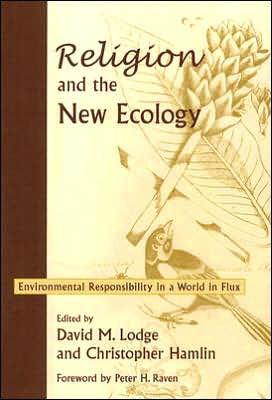
|
Posted November 7, 2006
Religion and the New Ecology: Environmental Responsibility in a World in Flux Edited by: David M. Lodge and Christopher Hamlin University of Notre Dame Press. Notre Dame, IN. 2006. Pp. 325 An Excerpt from the Jacket:
The contributors of this volume address how this new paradigm fits into the broader history of ecological science and the cultural history of the West and, in particular, how environmental ethics and ecotheology should respond to it. Their discussions ask us to reconsider the intellectual foundations on which theories of human responsibility to nature are built. The provisional answer that develops throughout the book is to reintegrate scientific understanding of nature and human values, two realms of thought severed by intellectual and cultural forces during the last two centuries. An Excerpt from the Book: Taken too far, the seductive image of a stable nature that would guarantee a harmony fro right-living people was incompatible with the recognition that nature changed. Increasingly, this seemed more than just a matter of timescales, with evolutionary biologists differing from ecologists by talking in terms of thousands or millions of years rather than tens or hundreds. The master model of nature was changing. The picture of a resilient system, full of subtle buffers and negative feedbacks that would dampen oscillations and restore equilibrium was giving way to an image of nature in flux, even when humans did not interfere with it. In this new view, nature consists, at least in part, of temporary and unstable states, which are often subject to fluctuations; steady long-term changes; and sudden shifts into quite different (only partially predictable) states, sometimes prompted by minor disturbances. And yet with regard to the public face of ecology, this revision was and is problematic. In the earlier period — when the metaphor of the balance of nature reigned – it had been easy to commit the naturalistic fallacy, for those willing to do so. Nature’s way was right. On the other hand, the images of flux and chance too have a heritage in Western culture, but a more complex and ambiguous one. The traditions associated with Heraclitus (all is flux) and Epicurus (all is the chance joining and separation of atoms) rather than that of the Stoics (all is harmony ruled by a universal soul) variously inspired skepticism, fatalism, materialism, quietism, fideism, nihilism, hedonism, mysticism, and romanticism. Particularly in America, where notions of providence, destiny, cosmic order, rationality, and progress loom large, the master image of flux is difficult to assimilate into public discourse. As the philosopher Stephen Toulmin has argued, these traditions continue to supply master narratives for human relations to nature, yet they require adaptation. For example, Heraclitus and Epicurus were thinking about how to respond to what nature threw at humans, not what humans throw at nature. Table of Contents: Introduction Beyond Lynn White: religion, the contexts of ecology, and the flux of nature 1. Christianity and changing concepts of nature: an historical perspective 2. Creating ecology: Protestants and the moral community of creation 3. Ecology and American social thought 4. The various Christian ethics of species conservation 5. Judeo-Christian perceptions of nature and its variability: a foundation for environmental awareness? 6. Disturbance, the flux of nature, and environmental ethics at the multipatch scale 7. Can nature (legitimately) be our guide? 8. Theology and ecology in an unfinished universe 9. Ecology and morality: the challenge to and from Christian ethics Conclusion Ecology and religion for a post natural world |
|
